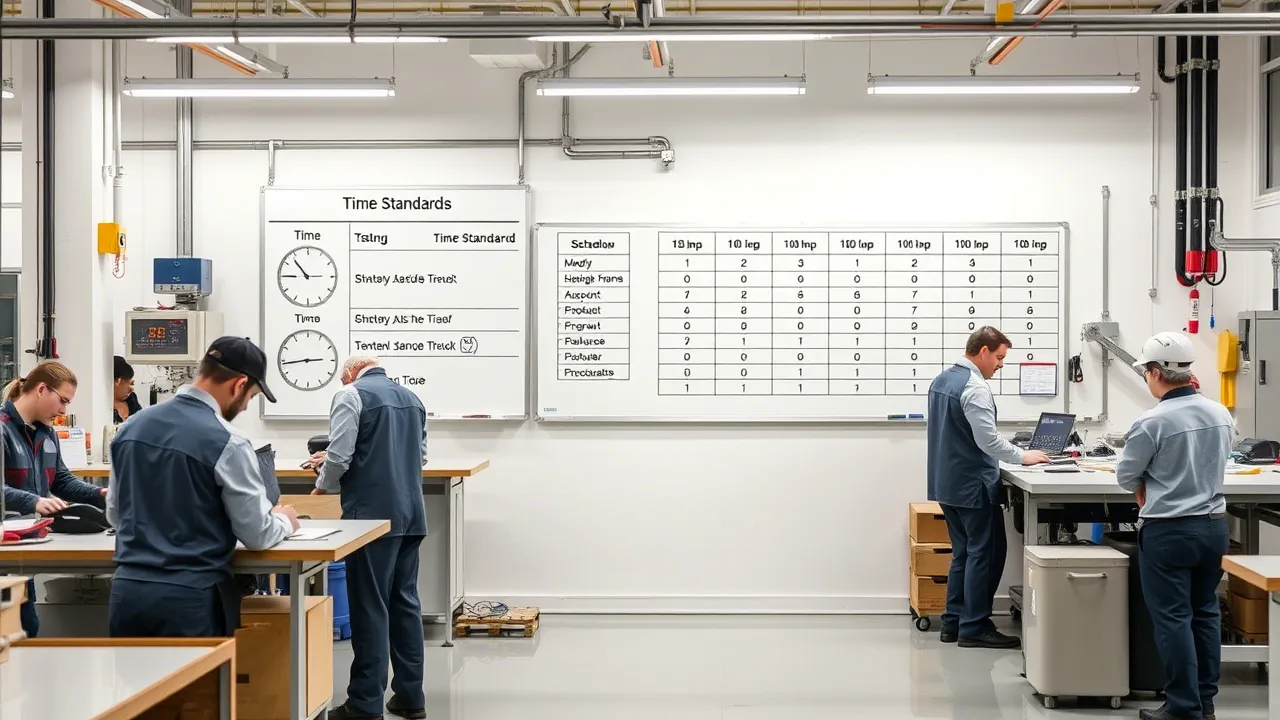1. Introduction: The Challenge of Standardization in the Modern Era
In today’s dynamic and competitive industry, work time standardization has become a crucial challenge for companies. The increasing complexity of production processes, increasingly demanding quality requirements, and pressure to optimize efficiency and profitability require organizations to have precise control of the time dedicated to each task.
This article offers an in-depth analysis of work time standardization, exploring its benefits, key steps for implementation, additional considerations, success cases, and relevant conclusions.
2. Benefits of Work Time Standardization
Work time standardization brings a series of tangible benefits to companies:
2.1 Greater efficiency:
-
Optimization of work time: Reduces downtime, eliminates unproductive activities, and improves work pace.
-
Improvement in productivity: Increases the amount of work done in a given period.
2.2 Better planning and control:
-
Precise production planning: Allows more accurate prediction of the time needed to complete tasks and production capacity.
-
Efficient allocation of human resources: Facilitates optimal distribution of the workforce according to production needs.
2.3 Cost reduction:
-
Decrease in overtime: Reduces the need for overtime and its associated costs.
-
Minimization of waste: Decreases waste of materials and rework due to errors or inefficiencies.
2.4 Quality improvement:
-
Process standardization: Establishes time standards for each task, ensuring a consistent work pace and reducing variability.
-
Error reduction: Decreases the probability of errors by establishing an adequate work pace and avoiding rushing.
2.5 Greater control:
-
Visibility over production pace: Allows the company to monitor and control the time dedicated to each task.
-
Improvement in decision making: Provides valuable information for decision making related to production and human resource management.
3. Key Steps to Implement an Effective Work Time Standardization System
To achieve effective standardization of work times, it is essential to follow a structured process:
3.1 Implementation of a time recording system:
-
Data collection: Record the time that workers dedicate to each task in a precise and detailed manner.
-
Recording tools: Use tools such as spreadsheets, specialized software, or time recording devices for data capture.
-
Data analysis: Analyze the collected data to identify areas for improvement, bottlenecks, and processes that require more time.
3.2 Establishment of time standards:
-
Definition of realistic standards: Define achievable and realistic time standards for each task, considering its complexity, worker experience, and environmental conditions.
-
Time study techniques: Use techniques such as time and methods study (MOST) to determine standards accurately.
3.3 Implementation of an incentive system:
-
Performance recognition: Reward workers who meet or exceed time standards, motivating their commitment and efficiency.
-
Types of incentives: Implement an incentive system that includes bonuses, salary increases, public recognition, or improvements in working conditions.
-
Alignment with objectives: Ensure that incentives are aligned with company objectives and contribute to the achievement of goals.
3.4 Performance evaluation:
-
Compliance monitoring: Periodically monitor workers’ compliance with time standards.
-
Identification of areas for improvement: Detect areas where training, adjustments in standards, or process improvements are required.
-
Feedback and adjustments: Provide constructive feedback to workers and make adjustments to standards when necessary.
4. Additional Considerations for Successful Implementation
4.1 Worker participation:
-
Involve workers in the process: It is essential to involve workers in the definition of time standards, as their knowledge and experience can be valuable for establishing realistic and achievable standards.
-
Effective communication: Clearly communicate time standards, expectations, and objectives of the standardization system to workers.
-
Training and support: Provide adequate training and constant support to workers so they can adapt to the new system and achieve time standards.
4.2 Effective communication:
-
Transparency and clarity: Communicate in a transparent and clear manner the objectives of the standardization system, time standards, and expectations at all levels of the organization.
-
Feedback and dialogue: Foster a culture of feedback and open dialogue to address workers’ concerns and continuously improve the system.
-
Constant communication: Maintain constant communication with workers to inform them about progress, changes, or adjustments to the system.
4.3 Flexibility:
-
Adaptation to changes: Adapt time standards and the standardization system to changes in production, market conditions, or customer needs.
-
Review and continuous improvement: Periodically review the standardization system and make continuous improvements to maintain its effectiveness.
4.4 Continuous improvement:
-
Improvement culture: Foster a culture of continuous improvement within the organization, constantly seeking to optimize processes and reduce work times.
-
Data analysis: Use data analysis to identify areas for improvement, quantify the impact of the system, and make informed decisions.
-
Innovation and technology: Implement new technologies and tools that facilitate data collection, time analysis, and management of the standardization system.
5. Success Cases: Companies That Have Achieved Effective Standardization
Various companies have achieved notable results by implementing work time standardization systems:
5.1 Toyota:
Pioneer in the Lean Manufacturing production system, which includes work time standardization as a fundamental element for efficiency and quality.
5.2 Ford Motor Company:
Significantly reduced its production costs by implementing a predetermined time system (MOST), achieving considerable savings.
5.3 Black & Decker:
Significantly improved its efficiency and productivity by standardizing work times in its manufacturing plants, increasing production and reducing costs.
6. Conclusion: Standardization as a Tool for Success
Work time standardization, if implemented effectively and strategically, can be a powerful tool for companies to achieve a higher level of efficiency, productivity, control, and profitability. By following the steps described, considering the additional recommendations, and learning from success cases, companies can optimize the use of their workers’ time, improve the quality of their products or services, and achieve their objectives in a competitive manner.
